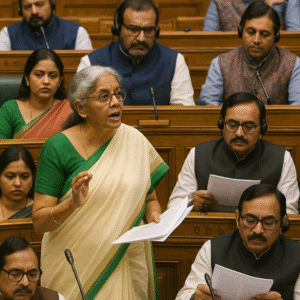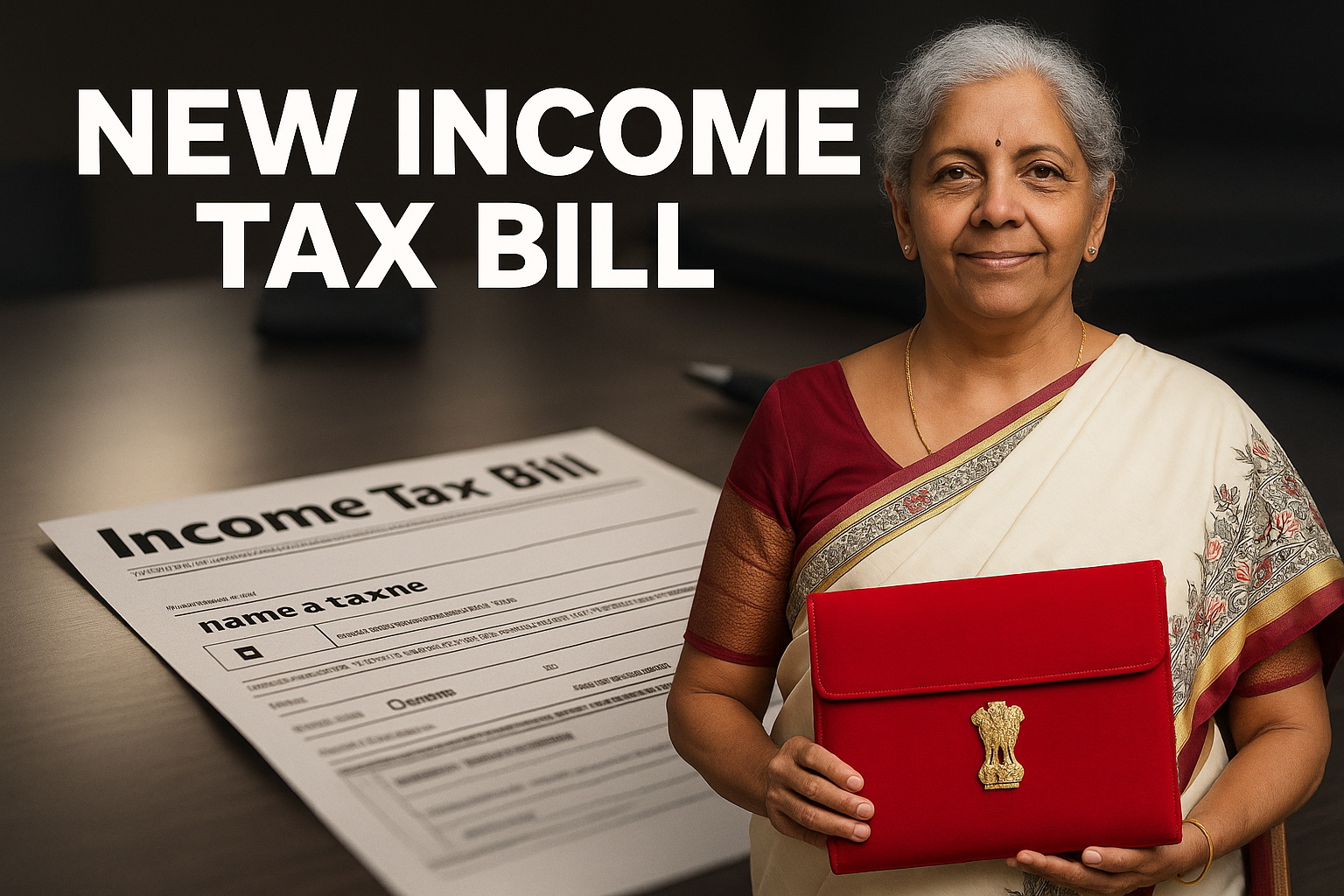Synopsis: India’s tax system is on the brink of one of its biggest updates in decades. On February 13, 2025, Parliament introduced the Income Tax Bill to replace the long-standing Income Tax Act of 1961, which has now been formally repealed.
But this move is not a rollback — it’s a step towards a more refined and taxpayer-friendly version, which will be reintroduced on August 11, 2025.
The upcoming bill aims to simplify tax laws, remove outdated provisions, and make the system easier to navigate for both individuals and businesses.
Table of Contents
New Income Tax Bill 2025: Why the Bill Was Changed
The earlier draft of the bill was reviewed by a Parliamentary Select Committee, which submitted its report on July 21. After a detailed examination, the committee proposed 285 changes. The government also took into account feedback from tax experts, industry bodies, and the general public.
The core focus areas for improvement were:
• Using plain, easy-to-grasp language so that common taxpayers can follow it without legal expertise.
• Standardizing terms and definitions to reduce confusion.
• Fixing cross-references so rules link correctly to related provisions.
• Eliminating obsolete or unnecessary provisions that have lost relevance over time
New Income Tax Bill 2025: Why Was the Original Bill Withdrawn?
The first draft had complex wording and some missing provisions, which could have led to misinterpretations. The revised bill keeps tax rates unchanged but aims to make the law clearer and more public-friendly.
There was also speculation in the media about changes to capital gains tax rates, but the Income Tax Department has officially clarified that this bill is not about changing tax rates — it’s about modernizing and simplifying the tax framework.
Major Reforms Proposed in the New Income Tax Bill 2025
1. Easier Tax Refunds
Old rule: If you filed your Income Tax Return (ITR) after the deadline, you couldn’t claim a refund.
New rule: Under Section 433, refunds will now be allowed even if the ITR is filed late, as long as it’s filed at all. Why it matters: This is a significant relief for taxpayers who miss deadlines but remain eligible for refunds.
2. Benefits for Companies on Inter-Corporate Dividends
In the earlier draft, the Section 80M deduction was unintentionally omitted for companies receiving dividends from other companies while opting for the special tax rate under Section 115BAA.
The revised bill restores this deduction, ensuring fairness and avoiding double taxation for such businesses.
3. Nil TDS Certificates
Taxpayers who expect no taxable income will be able to apply for a Nil Tax Deducted at Source (TDS) certificate.
Why it matters: This prevents unnecessary deductions for individuals and businesses with zero or minimal taxable income.
There are news articles circulating on various media platforms that the new Income Tax Bill, 2025 proposes to change tax rates on LTCG for certain categories of taxpayers.
— Income Tax India (@IncomeTaxIndia) July 29, 2025
It is clarified that the Income Tax Bill, 2025 aims at language simplification and removal of…
Also read about – Asim Munir threatens Mukesh Ambani, issues nuclear warning, and vows to damage Indian projects on Indus River, heightening India’s security concerns.
Pros and Cons of the New Income Tax Bill, 2025
Pros
• Clearer wording ensures the law is more accessible to all citizens.
• Refund eligibility extended to late filers, reducing taxpayer stress.
• Fairer corporate tax deductions through restored provisions.
• Better compliance as confusing clauses are removed.
• Prevents unnecessary deductions with Nil TDS certificates.
Cons
• No change in tax rates, so there’s no immediate monetary gain for most taxpayers.
• A phased transition period is planned to help both taxpayers and tax professionals adjust smoothly to the updated system.
• Possible initial confusion while switching from the old law to the new one.
Income Tax Slabs (FY 2024–25 – New Regime)
| Income Slab (₹) | Tax Rate |
|---|---|
| Up to 3,00,000 | NIL |
| 3,00,001 – 7,00,000 | 5% |
| 7,00,001 – 10,00,000 | 10% |
| 10,00,001 – 12,00,000 | 15% |
| 12,00,001 – 15,00,000 | 20% |
| Above 15,00,000 | 30% |
Note: If your income is up to ₹7 lakh, you’ll get a rebate under Section 87A, making your tax liability zero.
How a Bill Becomes a Law in India

1. First Reading – The proposal is formally presented in either the Lok Sabha or the Rajya Sabha.
2. Committee Review – It may be referred to a parliamentary committee for detailed study.
3. Second Reading – Members debate and suggest amendments.
4. Third Reading – Final discussion and voting in the house where it originated.
5. Other House Approval – The bill is sent to the other house for the same process.
6. President’s Assent – After both houses pass the bill, the President signs it.
7. Implementation – It becomes law and is enforced.
The Revised Income Tax Bill, 2025 is currently between the committee review stage and reintroduction for voting.
Impact of the new Income Tax Bill 2025
On India’s Economy:
The new income tax bill 2025 is to improve tax compliance, which could boost government revenues without increasing tax rates. By simplifying tax laws, it may attract more foreign investment and encourage greater business activity. Clearer provisions are also likely to reduce the number of legal disputes related to taxation.
On Ordinary Taxpayers:
Under the new income tax bill 2025 for individuals, filing returns will become easier because of the simpler language and structure of the law. Those who file late will still retain their right to claim refunds, and people without taxable income will no longer face unnecessary TDS deductions.
New Income Tax Bill 2025: Why This Update Was Long Overdue
Since April 1, 1962, the Income Tax Act of 1961 has served as the foundation of India’s taxation framework. In over six decades, it has been amended 65 times, with more than 4,000 individual changes, leading to a bulky and complex framework.
The new Income Tax Bill, 2025, is not just a legal update; it’s an effort to make the system simpler, fairer, and more efficient.
Final Takeaway
The new income tax bill 2025 is not about raising taxes — it’s about clarity, fairness, and ease of compliance. If passed, it could make paying taxes in India far less stressful for both individuals and businesses, while strengthening the country’s overall tax framework.
Frequently Asked Questions (FAQs) on the New Income Tax Bill 2025
1. What is an Income Tax Bill?
An Income Tax Bill is a proposed law that outlines the rules, rates, and procedures for collecting income tax in a country. It specifies who needs to pay tax, how it should be calculated, and the legal framework for compliance.
2. What is the New Income Tax Bill?
The new Income Tax Bill is a revised version of existing tax laws aimed at simplifying tax language, reducing legal disputes, improving compliance, and ensuring taxpayers face fewer unnecessary deductions or penalties.
3. Why was the Income Tax Bill revised?
The bill was updated to make tax rules easier to understand, encourage voluntary compliance, attract foreign investment, and ensure that both individuals and businesses can navigate the system without excessive legal hurdles.
4. What are the major changes in the new bill?
Key changes include simplified return filing, protection of refund rights for late filers, exemption from unnecessary TDS for non-taxable income earners, and clearer provisions that reduce ambiguity in interpretation
5. How will the new Income Tax Bill benefit ordinary taxpayers?
6. When will the new Income Tax Bill come into effect?
The effective date depends on when Parliament passes the bill and it receives the President’s assent. Typically, provisions may apply from the start of the next financial year unless otherwise specified.
The GeoLens – India || Defence || Global Affairs
Trump Tariffs India: U.S. Imposes 50% Tariff,

Pratik Kondawale
Strategist | Indian Defence & Global Affairs
Founder of GeoLens.in, Pratik writes in-depth analysis on India’s defence strategy, military tech, and global power shifts delivering sharp insights through an Indian lens.

